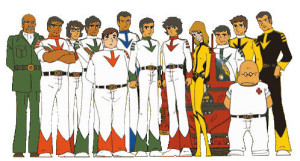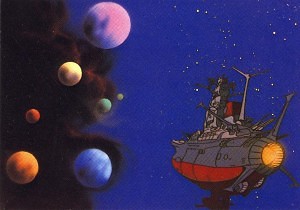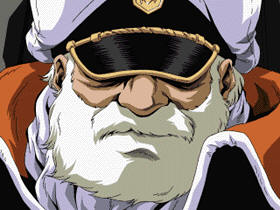 Original Screenplay by Tab Murphy
Original Screenplay by Tab Murphy
Draft dated September 10, 1997
If it seems like there is unending parade of cartoon and comic book adaptations making its way to movie screens, just remember that there are hundreds more that never it make it out of development and into active production. Fortunately, one of those projects that never saw the camera is Disney’s attempt at a live action adaptation of the classic 1970’s Japanimation import Star Blazers.
For the uninitiated, Star Blazers is the American retitling of the Japanese animated series Space Cruiser Yamato. Its first season premiered in Japan in 1974 and made its way to the States in 1979. It told the story of a future earth under attack from the evil Gamilon Empire (How do we know they’re evil? Well, ummm, their skin turned from fleshtone to blue about a third of the way through the first season for no apparent reason. That’s got to be evil…).
 The Gamilons have just about nuked the hell out of Earth and radioactivity will render our planet lifeless in one year’s time. Things look pretty hopeless until Earth receives an offer of help from the Princess Starsha of planet Iscandar. If the Earth can get a ship to Iscandar, Starsha will give them the Cosmo DNA, a device that will rid Earth of radioactivity and make it habitable again. She also supplies some technology to help the small band of adventurers make the perilous journey. Since most of the Earth’s fleet has been wiped out, the sunken WW2 battleship the Argo (Yamato in the original Japanese version) is retrofitted for spaceflight. The crew, known as the Star Force, are led by the wise and fatherly Captain Avatar and include the impetuous fighter jockey/weapons officer Derek Wildstar, his best friend Mark Venture, hottie nurse Nova, the frequently drunk Dr. Sane (although it wasn’t absolutely stated on the show, it was strongly implied), the engineer Orion, and the annoying (though not as annoying as that ‘bot over on Battle Of The Planets) comedy relief robot IQ-9.
The Gamilons have just about nuked the hell out of Earth and radioactivity will render our planet lifeless in one year’s time. Things look pretty hopeless until Earth receives an offer of help from the Princess Starsha of planet Iscandar. If the Earth can get a ship to Iscandar, Starsha will give them the Cosmo DNA, a device that will rid Earth of radioactivity and make it habitable again. She also supplies some technology to help the small band of adventurers make the perilous journey. Since most of the Earth’s fleet has been wiped out, the sunken WW2 battleship the Argo (Yamato in the original Japanese version) is retrofitted for spaceflight. The crew, known as the Star Force, are led by the wise and fatherly Captain Avatar and include the impetuous fighter jockey/weapons officer Derek Wildstar, his best friend Mark Venture, hottie nurse Nova, the frequently drunk Dr. Sane (although it wasn’t absolutely stated on the show, it was strongly implied), the engineer Orion, and the annoying (though not as annoying as that ‘bot over on Battle Of The Planets) comedy relief robot IQ-9.
Just ten years old when the show premiered, I thought it was fantastic. Each day, my friends and I would barrel home from school and head to one of the two houses on the block that had cable. Star Blazers was a core part of our afternoon TV diet- along with Speed Racer, Ultraman, The Space Giants and Battle of the Planets (The only American cartoons we would watch were the classic Bugs Bunny and Daffy Ducks from the 40s.). Star Blazers‘s mixture of outer space high adventure with a storyline firmly rooted in the mythic-quest tradition (The ship wasn’t renamed the Argo by accident) made a potent brew for a group of kids who were looking for a daily dose of Star Wars-type adventure.
 Tab Murphy had the unenviable task of compressing the show’s first season, the entire “Quest for Iscandar” storyline, from 26 half hour episodes down to an entertaining 2-hour film that remains faithful to the original material. Unfortunately, his Sept. 10, 1997 draft doesn’t manage to do it.
Tab Murphy had the unenviable task of compressing the show’s first season, the entire “Quest for Iscandar” storyline, from 26 half hour episodes down to an entertaining 2-hour film that remains faithful to the original material. Unfortunately, his Sept. 10, 1997 draft doesn’t manage to do it.
The first half of the script roughly follows the storyline of the series’s first handful of episodes. Faced with annihilation, the Earth receives a visit from a mysterious alien woman with a message of hope and an offer of help. A battleship is retrofitted for spacetravel and crewed by a group of brash, young warriors. But unfortunately, the devil lies in the details, or in this case, the changes that Murphy has made.
Some of these changes are cosmetic name changes. Derek Wildstar is now Derrick Wilder, Nova is now Jo and the Princess Starsha character is now called Nova.
But the most glaring name change is the renaming of the Yamato/Argo to the Arizona. Yes, the same Arizona that was sunk at Pearl Harbor. While some might like the nationalistic imagery of such a change, on a surface level it does subtract from the mythic underpinnings of the story. By changing the ship’s name to the Argo, the American producers of the cartoon created a link to the classic Greek tale of Jason and the Argonauts and the implication that the heroes of many lands are making this journey. Naming the ship to the Arizona subtly refocuses the story from the desperate race by people of many nations to save the planet to the United States saves the world. Again (See Independence Day.). It doesn’t help matters that Star Force headquarters is now located inside Mount Rushmore, parodied in last year’s Team America: World Police.
On a second level, changing the ship’s origin is a huge slap in the face to original series creator Yoshinobu Nishizaki. Nishizaki is reported to be a die-hard, anti-American patriot and the series can be viewed as a rather unsuitable metaphor for the post- World War II American occupation. Throughout the course of the series, the crew of the Yamato, an actual Japanese battleship sunk in the closing days of World war II, come to realize that by trying to totally annihilate the Gamilons, they would be no better than their enemies (Of course, such a culturally entrenched subtext would have been impossible to translate for American audiences, hence the renaming of the ship in the first place.).
The cartoon’s Captain Avatar was missing in action in the script for a proposed live action version of Star Blazers.
But there are also changes that are far less subtle, the most glaring change being the elimination of the Captain Avatar character. Avatar was the weathered and seasoned space captain who served as a mentor figure to the crew of the Argo, developing a fatherly role towards Derek over the course of the show’s first season. This elimination, again, undermines the mythic structure of the story. Avatar was the teacher figure in the tradition of Merlin, Gandalf and Obi-Wan Kenobi. It was his character that helped Derek grow over the first season and to overcome his anger over his brother’s death in combat with the Gamilons. With Avatar’s elimination, Wilder comes off as a brash hotshot who doesn’t really develop any further over the course of the film.
Another change to the character of Wildstar/Wilder, is the addition of a kid sister, Erika. Once she is introduced, you know that it’s only a matter of time before she stows away aboard the Arizona, not that her stowing away carries any major plot significance. She seems to be there just to have a kid aboard.
Unfortunately, the crew of the Arizona doesn’t rate much better in the characterization department. Rather than being the best Earth has to offer, they’re now a group who had mutinied aboard their own vessel two years earlier and have been languishing in the stockade ever since. Why is Wilder forced to use these men as crew? Why wouldn’t the best of Earth’s warriors want to participate in a last desperate gamble to save their planet? I couldn’t really tell you, because the main reason no regular soldiers would volunteer for the Iscandar mission (“I was born on Earth, I’m gonna die on Earth,” states an incidental character referred to as Fat Mechanic) doesn’t make much sense to me. Since we only have about two hours for this story and the rest of the crew are introduced about a third of the way into the movie we don’t even get to find out much about them as characters.
Once the Star Force is on its way to Iscandar, Murphy takes a radical left turn from the source material. Since in the film version, Nova personally delivers the offer of the Cosmo DNA, she now joins the crew for the trip back. With the ship damaged during their escape from Earth, the Arizona makes a stop for supplies at the planet Sega (No doubt named in a triumph of product placement over good taste!). The crew gets the needed supplies, but not without a deadly run-in with the local insectoid population.
 Returning to the Arizona, Wilder and company manage to head off a boarding attempt by some Gamilon soldiers. It’s also around this point that Murphy realizes he has to wrap things up fairly quickly. Nova reveals herself to be the half-Gamilon daughter of Leader Desslock, the Gamilon’s commander. She reveals that she is actually taking the Star Force to the planet Gamilon itself to retrieve the Cosmo DNA.
Returning to the Arizona, Wilder and company manage to head off a boarding attempt by some Gamilon soldiers. It’s also around this point that Murphy realizes he has to wrap things up fairly quickly. Nova reveals herself to be the half-Gamilon daughter of Leader Desslock, the Gamilon’s commander. She reveals that she is actually taking the Star Force to the planet Gamilon itself to retrieve the Cosmo DNA.
Somehow, the Arizona makes it into the Gamilon system undetected and members of the Star Force are able to infiltrate Desslock’s headquarters and steal the Cosmo DNA. Meanwhile, Derrick has a face-to-face meeting with Desslock while disguised as a Gamilon officer. A race back to Earth ensues, followed by a battle in which Nova sacrifices herself to ensure victory. It is also discovered that someone in Earth’s High Command is a traitor and has been hindering the Star Force from the beginning, though the script makes it pretty obvious who it is from the beginning. A quick coda featuring the activation of the Cosmo DNA and restoration of Earth wrap the story up.
The basic failing of the second half of the script is that with all the set up of the first hour, Murphy is under pressure to reach a speedy conclusion. Thus we have the cheat of never getting to Iscandar and having our heroes fight their way back to Earth. It is all set up and resolution, no complication. As the old saying goes, “It’s not the destination that’s important, it’s the journey.” Also, the mythic structure of the original is shot to pieces. The changed ending also invalidates the entire setup of the film, promising us one thing and than telling us “Just kidding!” There’s a difference between plot twists and just plain bad plotting and this definitely falls into the latter category.
Ultimately, the idea of turning Star Blazers into a live action film may sound fun at first, but the two-hour film format doesn’t contain enough room to do the concept justice. Disney would be better off developing the material as a six to ten hour miniseries for television. And we could end each evening with the cartoon’s chilling closing voiceover, “Can the Star Force do it? Earth has only X days left!”.



